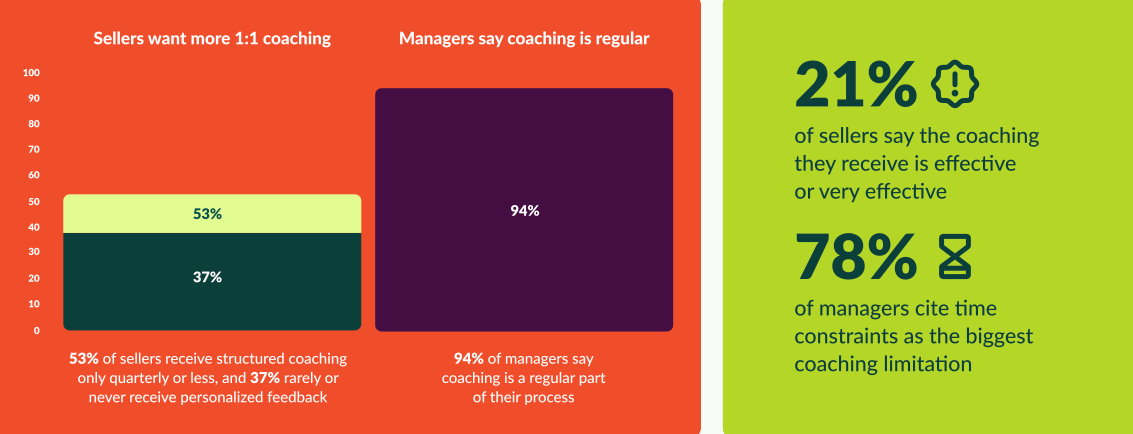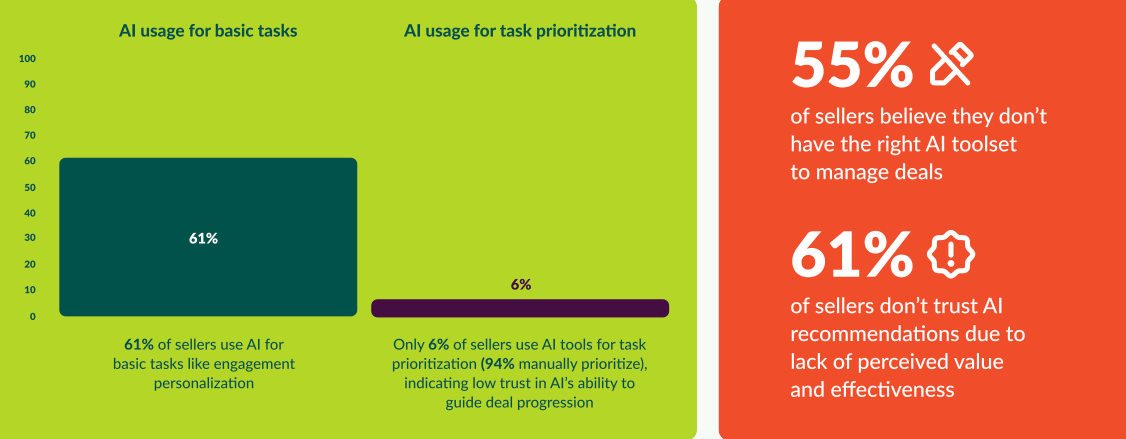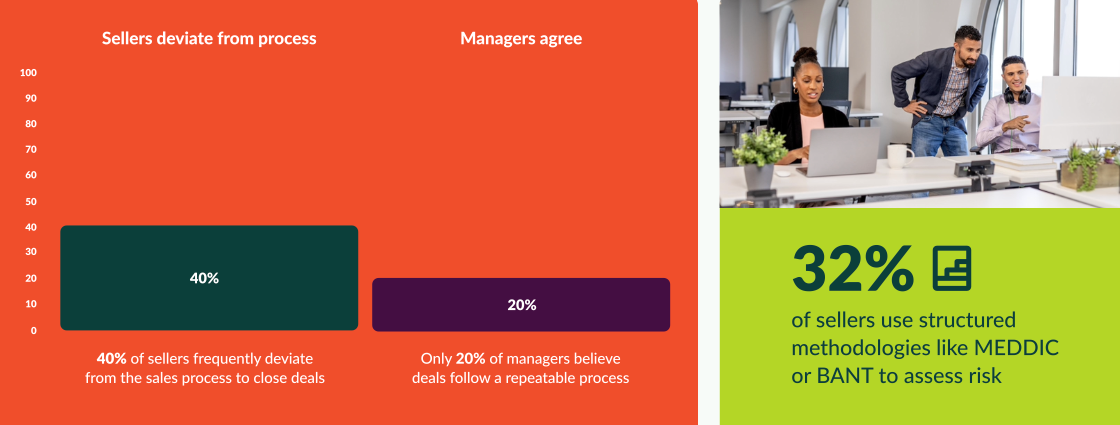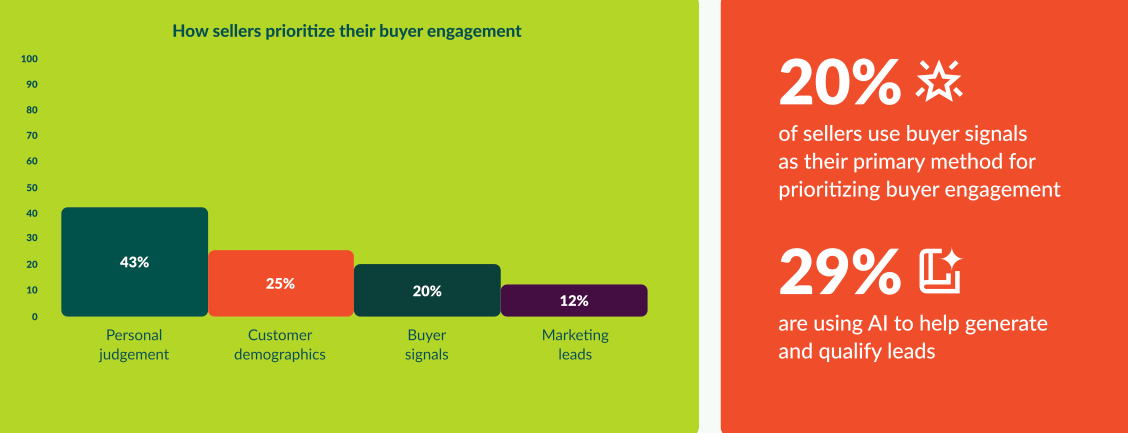Study: The Most Critical Sales Skill Gaps in 2025
Published:

Why we did this
Revenue leaders are facing a tough challenge: How do you hit ambitious targets with fewer resources, all while preparing your sales teams for what’s next?
New tools, training programs, and refined sales processes haven’t closed the execution gaps. What drove success yesterday won’t guarantee results tomorrow. It’s time to dig deeper and understand why.
Specifically, we set out to:
- Identify how sellers approach their work, where they’re struggling, and how managers view those challenges
- Compare self-assessments with manager feedback, to see why reps say one thing and managers say another
- Determine the critical skill gaps preventing sellers from executing consistently
By digging into the behaviors, perceptions, and challenges of today’s sales teams, our goal is to help revenue leaders identify the root causes of inconsistent performance and find practical ways to fix them.
Ultimately, this is about helping teams perform at their best and put wins on repeat.
Methodology

How we collected the data
Method: Online survey with a mix of multiple-choice questions and open-ended responses to get both quantitative and qualitative insights
Focus areas:
- How sellers and managers engage buyers, manage pipeline, and make decisions
- The skill gaps preventing consistent execution
- Discrepancies between rep self-assessment and manager evaluation
- The impact of AI adoption, coaching practices, and sales processes on performance
Executive briefing
2025 is the year of contradictions
- Reps have confidence. Managers have doubts. 85% of sellers rate themselves as strong in prospecting, 83% in executive engagement, and 73% in risk detection. However, 56% of managers say reps miss critical risks that stall deals, and only 48% trust their reps to run deals independently.
- Coaching isn’t personalized, so reps aren’t improving. 94% of managers claim coaching is part of their process, but 53% of sellers say they receive coaching quarterly or less, and 37% rarely or never receive personalized feedback. 78% of managers cite time constraints as a primary limitation.
- AI is available. But underutilized. Only 6% of sellers use AI tools for task prioritization, and 55% feel they lack the right AI toolset to prospect and manage deals effectively. The most common AI uses are engagement personalization (61%) and call recordings analysis (51%), not coaching.
- Process compliance is a myth. 40% of sellers frequently deviate from the sales process, and only 20% of managers believe deals follow a repeatable process. Reps rely on gut feeling over data. 43% of sellers prioritize buyer engagement based on personal judgment, 25% rely on customer demographics, and only 20% use buyer signals.
- Reps are overwhelmed by the wrong tech investments. The top barriers to tech adoption are tool complexity and perceived value, with 55% of sellers lacking access to AI tools and 53% needing more time and training. Instead of streamlining workflows, disconnected tools create friction, making it harder for sellers to adopt and leverage their tech.
- Adaptability is the most desired soft skill. 44% of managers say adaptability is the most crucial soft skill for sales success, but it s often overlooked.

The 7 biggest takeaways
Takeaway 1: Reps have confidence. Managers have doubts.
"They don't follow the playbook consistently — specifically, the multi-threading piece and champion testing in the early stages." – Kylie, Sales Manager
What this means
Reps think they’re performing well, but managers don’t have the same perception. Only 44% of managers think their reps are effective at spotting risks and moving deals forward. This forces managers to step in more often than they should, slowing down deal cycles and making it harder to scale.
This indicates that more targeted, personalized coaching is needed by many sales teams. 41% of managers say reps struggle to engage executive buyers, and 56% say reps miss critical risks that stall deals. This gap between self-assessment and execution shows that confidence doesn’t always lead to results.
The right technology can help close the execution gap by embedding best practices into daily workflows. It should:
- Auto-capture buying group members to avoid missed stakeholders
- Analyze stakeholder engagement to identify gaps in influence
- Flag deal risks in real time so managers can coach before issues escalate
Takeaway 2: Coaching isn’t personalized, so reps aren’t improving
"The most significant skill gap among my sales representatives is consistency." – Melissa, Broker Sales Manager

What this means
Most managers think they’re coaching, but reps don’t see the impact. The little coaching that reps receive is not effective: 78% of sellers said their sales coaching was moderately effective or worse. Coaching is reactive and inconsistent, usually squeezed between deal reviews and pipeline checks. It’s not structured to develop skills or improve execution.
As a result, 37% of sellers say they rarely or never receive personalized feedback, just 21% say their coaching is effective, and 20% specifically requested personalized coaching in the survey.
To develop top performers, you need a system that overcomes time constraints and lack of structure by diagnosing skill gaps, enabling managers to deliver targeted feedback, and driving sustained improvement. This means using data to prioritize the most impactful coaching moments and codifying the approach so every rep gets actionable feedback and can consistently improve their skills and results.
To get there, leaders need a solution that:
- Identifies skill gaps with data-driven insights based on deal progression and customer conversation
- Prioritizes coaching based on team goals and benchmarks, tracking progress and performance with custom dashboards
- Prompts proactive, timely coaching for sellers who are struggling, using AI to highlight where reps need help
- Maintains consistency by operationalizing feedback and coaching practices to ensure sustained skill growth and improved outcomes
Takeaway 3: AI is available. But underutilized.
"The problem is that they could be so much better at using automation or AI stuff to help them with their processes." – Brian, Sales Director

What this means
Reps use AI for tasks like email personalization and call summaries but don’t trust it for high-stakes decisions like deal progression and risk assessment.
55% of sellers say they don’t have the right AI toolset to help them prospect for new opportunities and manage, forecast, and close their existing opportunities. As a result, they view AI as a tactical aid rather than a strategic advisor. Without understanding why a task is prioritized — due to a lack of context about its recommendations — reps default to their own judgment. This undermines the value of AI.
If the AI isn’t helping people in a way that is best practice, it’s simply helping them be efficient yet still ineffective. This trust gap exists when AI lacks explainability. 61% of sellers don’t trust AI recommendations because they are skeptical about its value and effectiveness.
Reps need to understand the “why” behind each recommendation, especially when it influences critical decisions. When AI provides that context, it builds trust and drives action.
To build that trust, leaders need a solution that:
- Explains why each action is prioritized, so reps understand the rationale behind the recommendation
- Links AI insights to specific sales outcomes, connecting recommendations to real business impact
- Builds intuition for new reps, helping them learn not just what to do, but why it matters
Takeaway 4: Process compliance is a myth
"The most significant skill gap for our sales reps today is a repeatable sales process which is making it difficult for us to scale." — Alex, Business Unit Leader

What this means
There's a disconnect between your defined sales process and how deals are actually executed. Nearly half of your sellers deviate from the plan, and most managers recognize the inconsistency. This gap leads to unpredictable outcomes and makes it difficult to forecast accurately.
A strong sales process should be a flexible framework, not a rigid set of rules. It should guide reps while allowing them to adapt to the unique needs of each deal. However, with only 32% of your sellers using proven methodologies like MEDDIC or BANT, inconsistent execution remains a challenge. This highlights the need for better enablement to equip reps for success.
Managers report that some of the biggest seller skill gaps are the ability to effectively use technology and adhere to a consistent sales process. This is where automation and AI Agents can help. By embedding best practices and intelligent guidance directly into your reps' workflow, you can ensure consistent execution without stifling their ability to adapt. This allows you to:
- Automate key actions, such as meeting prep and follow-up based on real-time signals like intent scores and product usage changes
- Guide reps with dynamic next steps that adapt to deal changes
- Operationalize qualification frameworks like MEDDIC to assess risk and forecast accurately
It’s not about rules, it’s about results. Agile processes guide reps without constraining them.
Takeaway 5: Reps rely on gut feeling over data
"Many sales reps need to be able to see a way to get multi-threaded in an organization so they are not blocked by one single stakeholder to get wider in an account." – Kylie, Sales Manager

What this means
Sales teams struggle with where to spend their time and effort. For mid-market teams, the issue is chasing low-probability deals. In enterprise sales, it’s taking the wrong actions within high-value accounts. Either way, these things lead to wasted time and missed revenue.
Most reps have plenty of data but often miss what truly matters. They not only spend time on tasks that don't move deals forward — they also overlook key opportunities. For example, they might miss upsell or account health signals, or fail to engage an executive stakeholder when needed.
To address this, leaders need a solution that:
- Prioritizes high-value deals by analyzing real-time buyer behavior
- Leverages historical data to reveal which actions drive successful outcomes
- Alerts teams to risks and opportunities so managers can coach at the right moment
- Guides reps on the best next steps at every stage, from initial contact to expansion
It’s not just about avoiding the wrong actions — it’s about seizing the right ones at the right time.
Takeaway 6: Reps are overwhelmed by the wrong tech investments
"Lack of understanding with CRM technology and the benefits it provides over the long term is a problem." –Chris, Territory Sales Manager

What this means
Reps are overwhelmed by disconnected tools, and they don’t have access to the AI capabilities they need to be effective. Instead of streamlining workflows, current sales investments create complexity, making it harder for sellers to adopt and leverage their tools.
- 40% of managers say sellers are not effective at using all the sales tools at their disposal
- 57% of sellers are not confident in leveraging AI to enhance productivity, generate pipeline, and close deals
Adding more point solutions won’t fix this. Disconnected tools create friction that drains productivity. At the enterprise level, shifting to an AI-powered Revenue Orchestration Platform can save upwards of $750k in annual costs. Reps need one environment to manage everything — prospecting, progressing deals, and coaching — with an open API to integrate a broad ecosystem of signals. This includes critical tech stack integrations and customers’ own proprietary data, providing a comprehensive view of buyer behavior and deal progress.
This is where a Revenue Orchestration Platform shines.
By consolidating essential functions and connecting to a wide range of data sources, it empowers reps with the insights and AI agents they need to take action and helps teams scale and focus on closing deals.
The most effective approach should:
- Establish a central hub that ties essential functions together, rather than piling on point solution
- Automate CRM updates and unify data across all interactions to provide managers with accurate forecasting and reps with actionable insights, eliminating manual data entry and ensuring data trustworthiness
- Embed AI agents into the workflow to handle repetitive tasks, provide recommendations, and elevate sellers so they can focus on building relationships and winning deals
Takeaway 7: Adaptability is the most desired soft skill
"Reps need to have the ability to use new tools and learn new skills at hyper speed." – Survey respondent

What this means
AI is transforming sales by automating tasks and providing powerful insights. But the most important competitive advantage? Human adaptability.
Deals are more complex today, and priorities can shift quickly. Reps need to be flexible to keep up. But most sales tools, like CRMs, are built to organize data — not to help reps adapt in real time. They provide a snapshot of what’s happening but they don’t guide reps on how to respond.
A Revenue Orchestration Platform fills this gap by aligning sales actions with buyer behavior, making it easier for reps to adjust their approach. It also:
- Provides context so reps understand why they’re taking action
- Embeds AI agents that learn from all interactions to help improve efficiency and effectiveness
- Shows real-time signals that help reps pivot as deals change
- Delivers continuous feedback so reps can learn and adapt on the go
With the right tools in place, reps can tap into the skills that make them uniquely human, keeping deals moving forward even as buyer needs change.
Execution gaps are your biggest competitor
Winning in 2025 means breaking through the contradictions holding your team back. To prepare your sellers and coaches for the future, you’ll need to:
- Measure outcomes, not activities, to see who’s really moving the needle
- Use data to coach on specific skill gaps, not just generic advice
- Explain the “why” behind AI’s suggestions to build trust and drive adoption
- Make playbooks flexible and adaptive so reps stay aligned without feeling boxed in
- Use buyer signals and AI prioritization to focus reps on high-impact deals and the right actions
- Connect actions, AI agents, and workflows into one platform so reps stay focused and productive
- Give reps real-time insights so they can adjust on the fly as buyer needs change
Salesloft puts your revenue wins on repeat
Tour the platform




























